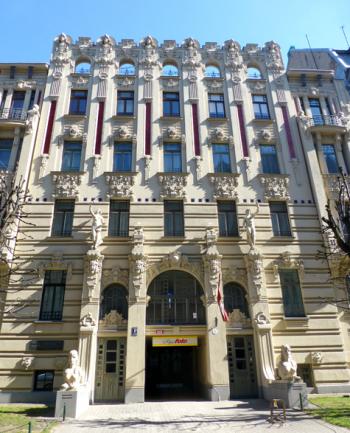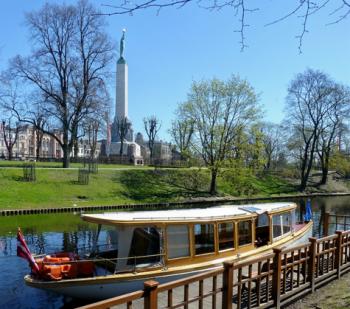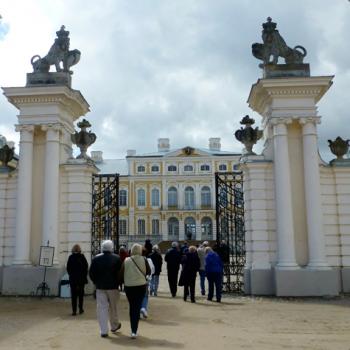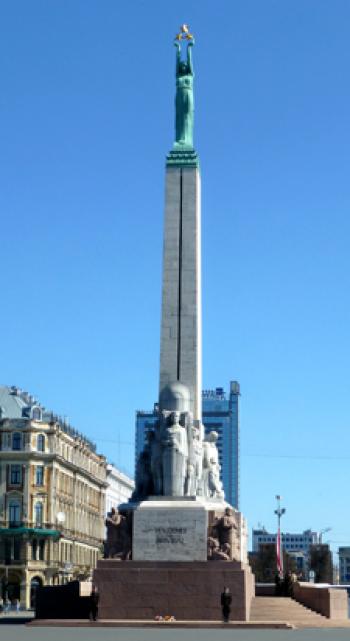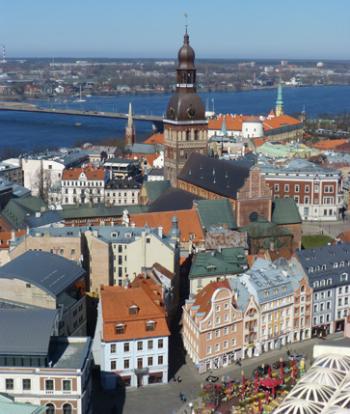The Baltics (Part 2 of 3)
This item appears on page 57 of the September 2017 issue.
Riga, Latvia
(Second of three parts)
The second leg of my spring 2017 visit to the Baltic States began with a relaxing drive from Vilnius northward through the peaceful countryside of north-central Lithuania and into Latvia, a country with a population of just under two million.
I was traveling, on a partially hosted basis, as part of a group of 15 on a 2-week “Baltic States & Berlin” tour with smarTours (New York, NY; 800/337-7773, www.smartours.com).
En route to the Latvian capital of Riga (pop. 700,000), where we were based for three nights, we stopped to visit the ornate, 18th-century Runda¯le Palace, a Baroque country complex that, beginning in 1736, was constructed in stages. Our guided tour revealed a visual feast of impressive Rococo interiors.
Runda¯le was used as an elementary school and granary during much of the period of Soviet rule. Its restoration commenced in 1972 and continues today. The palace grounds feature 10 hectares of manicured gardens, including extensive rose gardens. Unfortunately, our late-April visit was ahead of the summer bloom.
Riga beckons
The charm and allure of Riga is defined by the combination of its inviting medieval Old Town and the greatest concentration of (and, in the opinion of UNESCO, the finest array of) Art Nouveau buildings found anywhere in the world.
Riga was originally constructed along the right bank of the Daugava River. For many centuries it was contained within protective city walls, but in the mid-19th century the walls were removed so the city could expand.
This compact area, now known as Old Town, contains the majority of the most interesting and important sites, many situated on the streets around Town Hall Square. Mercifully, only one of the city’s many squares experienced any damage from bombings during WWII.
About three-quarters of a mile from the entrance to Old Town, our hotel was located at the edge of the Art Nouveau district. Most of the key Art Nouveau sites could be viewed on a walk along three ielas (streets): Elizabetes, Stre¯lnieku and Alberta. Local brochures with maps detailing the most prominent Art Nouveau buildings were readily available.
A shortcut from our hotel allowed us to reach the Freedom Monument, near the primary entrance to Old Town, in about 15 minutes. It’s a spectacular sight.
Our whirlwind walking tour of the well-preserved Old Town included the expansive and very photo-friendly Central Market, with several buildings displaying seafood, meats, fruits, vegetables, flowers and other local favorites. Amazed at the number of vendors offering bountiful arrays of smoked fish, I concluded that the Riga Central Market must be the smoked-fish capital of the universe.
Several in our group were so taken with the market that they returned during our free afternoon.
Taking to the streets
Around the rim of Riga’s Old Town, public buses and trolleys provide easy and quick transport around the city, but Old Town, itself, is best explored on foot, since there is no public transportation and because autos are allowed on only a few streets. Two tourist information offices in the area provide details about guided tours and other activities.
On a free afternoon, after walking for hours in Old Town, I visited the giant department store Stockmann in search of truffles, which I purchased at a price less than half that of the same item in the Stockmann store I later visited in Helsinki. (Who knew?) Being able to take a trolley (€2) back to within a block of our hotel was definitely a blessing.
My free-time exploration of Old Town had a few specific objectives. First up was getting a bird’s-eye view of Riga from the viewing platform at historic St. Peter’s Church. The sweeping views over Old Town, greater Riga and the Daugava River were well worth the entry fee of €9 (near $10.70).
Note: The rather slow elevator to the platform holds only 20 people, so during busy periods at the top, pay attention to the line forming to go back down.
Next, I quickly made my way to the Dome Cathedral, about 400 meters away, via a series of alleyway shortcuts. I arrived 20 minutes before the touted pipe organ recital that takes place daily at 12 noon and purchased a ticket (€10).
Within a few minutes, a flood of tourists began arriving and the ticket line quickly backed up. Alas, the 20-minute organ recital turned out to be a bit disappointing, and many departed before it had concluded.
It was lunchtime, and the search was on for just the right outdoor café. The brew pub Colonel (KaLku Iela 20, Riga; phone +371 65822626), on bustling, photogenic Livu Square, proved the perfect choice in terms of cuisine and ambiance.
While the service was a bit slow, the tasty Belgian fish stew served with fresh, local sourdough accompanied by a thirst-quenching Latvian dark draft, all for €9.20, was perfect. I lingered for a while in this historic-square setting, feeling grateful for my good fortune.
Parting views
My final “must do” in Riga was taking the one-hour, narrated canal-boat cruise on the City Canal and the Daugava River. The circuit passes many of Riga’s top attractions, providing a complimentary visual perspective of the city. I recommend this relaxing cruise, which costs €18, with boats departing every 30 minutes on the hour and half-hour from the City Canal dock near the Freedom Monument.
SmarTours offered two optional tours in Riga. The 4-hour excursion to the nearby seaside resort of Jurmala ($55), with its unique wooden cottage architecture, received mixed reviews.
An afternoon “Jewish Heritage Tour” was also offered ($50). I chose to spend that time exploring Riga on my own, but those who participated gave the tour a resounding thumbs up.
Next month, I’ll describe what we found in Estonia and its lively capital, Tallinn.
You may reach Randy at 80 America Way, Jamestown, RI 02835; 401/560-0350, randykeck@yahoo.com.

